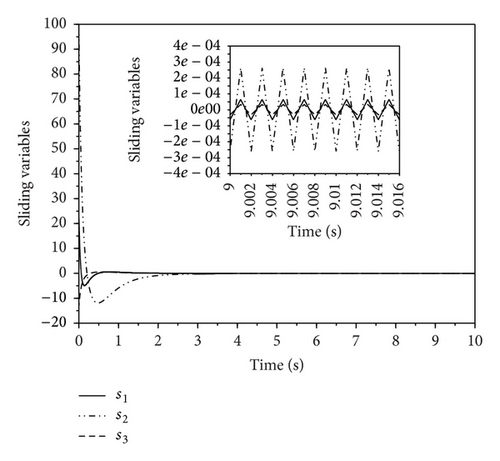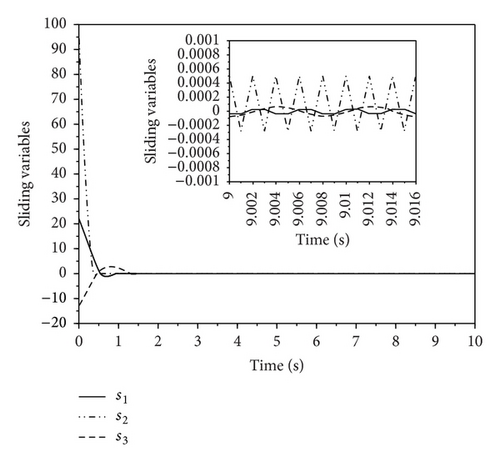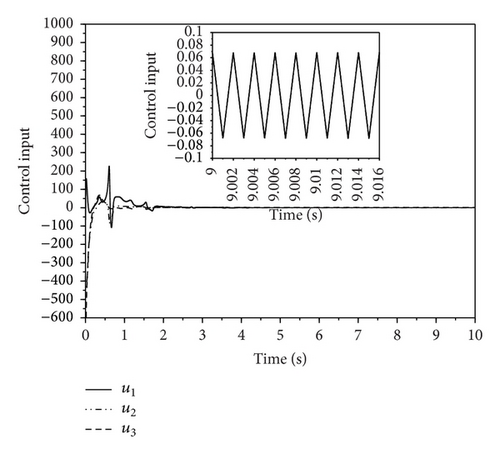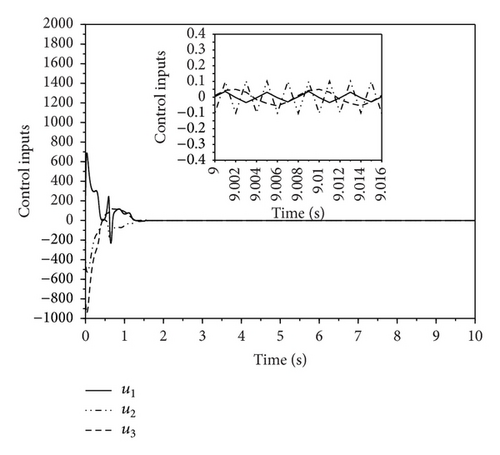Finite-Time Synchronization for Uncertain Master-Slave Chaotic System via Adaptive Super Twisting Algorithm
Abstract
A second-order sliding mode control for chaotic synchronization with bounded disturbance is studied. A robust finite-time controller is designed based on super twisting algorithm which is a popular second-order sliding mode control technique. The proposed controller is designed by combining an adaptive law with super twisting algorithm. New results based on adaptive super twisting control for the synchronization of identical Qi three-dimensional four-wing chaotic system are presented. The finite-time convergence of synchronization is ensured by using Lyapunov stability theory. The simulations results show the usefulness of the developed control method.
1. Introduction
Synchronization of chaotic system has been of increasing interest in recent years owing to its effective applications in secure communication, power convertors, biological systems, information processing, and chemical reactions [1, 2]. A fundamental concept for chaos synchronization is to use the outputs of the master system to control the outputs of the slave system so that the states of the slave system track the states of master system. In practice, it is difficult to know the parameters of a chaotic system precisely and external disturbance always occurs in the system. Thus, synchronization of chaotic system in the presence of parameter uncertainties and external disturbances is effectively crucial in applications. Various nonlinear control methods have been proposed to deal with the problem of synchronization of uncertain chaotic systems such as adaptive control [3], passive control [4], sliding mode control [5, 6], backstepping control [7, 8], and fuzzy control [9].
Sliding mode control (SMC) [10, 11] is an effective nonlinear control method to deal with a system with uncertainties and external disturbance. However, there are two main drawbacks of sliding mode control. First, the convergence of system states to the equilibrium point is asymptotical, so the system states cannot converge to the equilibrium point within a finite time. The second drawback is the chattering phenomenon. Second-order sliding mode control (SOSMC) [12–14] is the enhanced SMC method which is developed to maintain good properties of SMC and reduce the chattering effect. Moreover, the recent SOSMC is designed based on the finite-time stability [15, 16]. This can improve the convergence speed of SMC and keep the desired properties of SMC.
The aim of this paper is to design a robust finite-time feedback control for chaotic synchronization. As is known, the super twisting algorithm is in a class of second-order SMC and is widely used in many practical applications [17–19]. Moreover, to deal with uncertainties and disturbance, the adaptive tuning law is combined with the super twisting algorithm. This adaptive law is used to update the controller gains and this relaxes the requirement of information of the bound of uncertainties and disturbances. The resulting controller is called adaptive-gain super twisting controller (AGSTC).
The rest of this paper is organized as follows. In Section 2.1, the synchronization problem is formulated and concepts and lemmas of finite-time stability are given. Section 2.2 presents the controller design for the synchronization problem via SMC. In Section 2.3, a robust finite-time controller design is proposed. The proposed adaptive super twisting controller is developed to achieve finite-time synchronization. Section 2.4 discusses the synchronization of identical Qi four-wing chaotic system. Section 3 presents the simulation results. Conclusions are provided in Section 4.
2. Materials and Methods
2.1. System Description and Problem Statement
-
master system:
() -
slave system:
()
We consider the master and slave chaotic systems described by (1) and (2), respectively. The aim is to find a controller u so that the error state e converges to zero in a finite time represented by a constant T = T(e(0)) > 0. In other words, we need limt→T‖e(t)‖ = 0 and ‖e(t)‖ ≡ 0, when t ≥ T. This implies that the chaos synchronization between chaotic systems (1) and (2) is realized in the finite time T. We now restate the concepts related to finite-time stability presented by Bhat and Bernstein [15, 16].
Lemma 1 (Bhat and Bernstein [15]). Consider the system
Lemma 2 (Yu et al. [20]). For any numbers λ1 > 0, λ2 > 0, and 0 < ϖ < 1, an extended Lyapunov condition of finite-time stability can be given in the form of fast terminal sliding mode as
2.2. Synchronization via Sliding Mode Controller
Theorem 3. Master system (1) and slave system (2) are globally and asymptotically synchronized for all initial conditions x(0), y(0) ∈ Rn by the feedback control law (13).
Proof. Substituting (13) into (4), we obtain
2.3. Adaptive-Gain Super Twisting Controller
The super twisting control law is the most powerful second-order continuous sliding mode control algorithms. It generates the continuous control function that drives the sliding variable and its derivative to zero in finite time. Next, we add an adaptive law to the classical super twisting algorithm to tune the controller gains and avoid knowledge of upper bound of the vector .
Assumption 4. The new disturbance ξ(t) and its first-time derivative δ(t) are bounded; that is, |ξ(t)| ≤ D1 and |δ(t)| ≤ D2, where D1 and D2 are positive constants.
Theorem 5. Let Assumption 4 hold. With μ > 0 and λ1 > 0 and λ2 > 0 and L(t) defined in (20), all states (z1 and z2) of system (24) converge to the origin in finite time.
Proof. We first introduce the new vector . Its time derivative is given by
Let the Lyapunov function be chosen as
2.4. Synchronization of Identical Qi Four-Wing Chaotic System
-
master system:
() -
slave system:
()
3. Results and Discussion
In this section, numerical simulations are performed to compare the performances of sliding mode control (SMC) defined in (13) and adaptive-gain super twisting control (AGSTC) defined in (21).
The simulation results of synchronization under SMC and AGSTC are shown in Figures 1–8. As shown in Figures 1 and 2, for AGSTC the states of slave system quickly track the states of master system when compared with SMC. Similarly, Figures 3 and 4 show the error of synchronization in which AGSTC provides faster rate of convergence. For AGSTC, the synchronization error is larger than the one obtained by SMC because the control parameters λ1, μ, and L(t) updated by (43) are chosen large enough to ensure the disturbance rejection ability. This leads to larger synchronization errors obtained by AGSTC as shown in Figures 3 and 4. From Figures 5 and 6, we can see that, for AGSTC, the sliding variables reach zero quicker. In Figures 7 and 8, the control inputs obtained by AGSTC are smoother than SMC. From these simulation results, it is clearly shown that AGSTC gives better results of synchronization.








4. Conclusions
A robust finite-time controller has been successfully applied to synchronize identical Qi three-dimensional (3D) four-wing chaotic systems. The proposed control law is designed combining the super twisting algorithm with an adaptive tuning law. The finite-time convergence of synchronization error is proved using the Lyapunov stability theory. Numerical simulations are provided to validate synchronization results of the developed control method.
Competing Interests
The authors declare that they have no competing interests.




